During WWII, the government commissioned propaganda posters to teach American citizens and soldiers that careless speech could endanger national security. Any American with knowledge of troop movements, military equipment, or any other information that might prove useful to the enemy was encouraged to keep quiet. To remind all Americans of their duty, the Office of War Information (OWI) commissioned artists to create propaganda posters. The posters were hung in public places and widely reprinted. They used imagery that tugged at heartstrings, invoked fear, and appealed to a sense of patriotism. Fold3 has an archive of WWII propaganda posters found in our Boston Public Library collection. Here are a few of those propaganda posters and a little about the artists that created them.
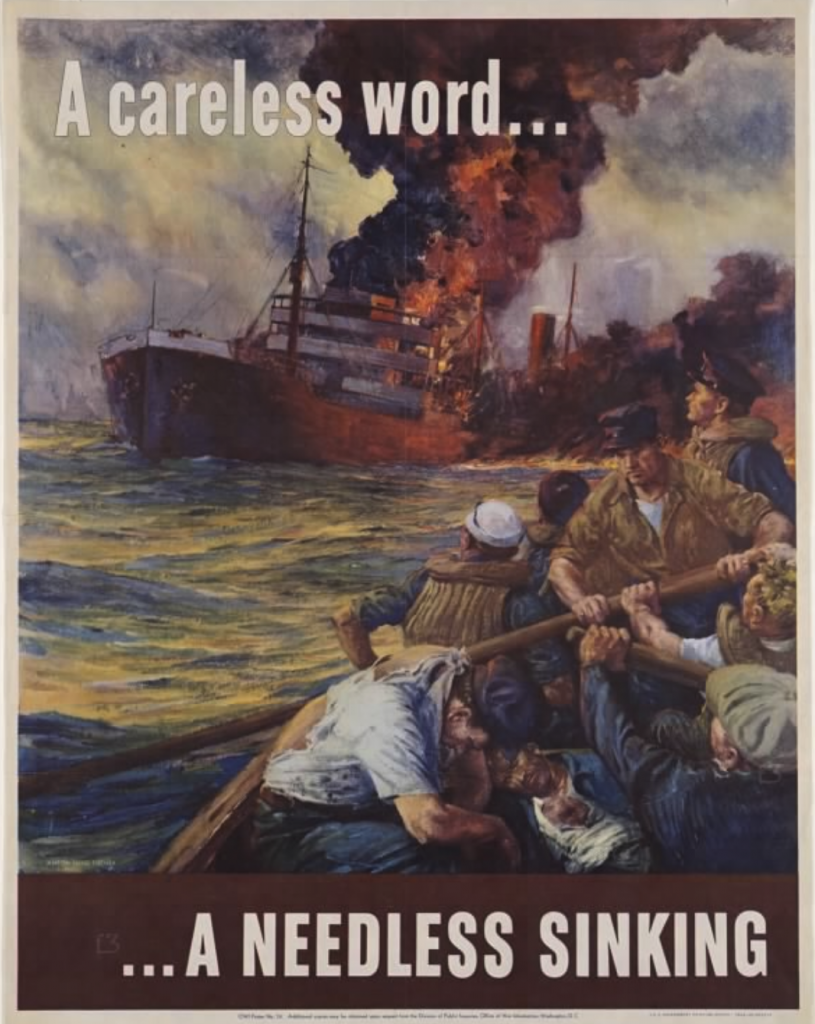
Anton Otto Fischer was a native of Germany and an illustrator for the Saturday Evening Post. His seascapes attracted the attention of Russell Waesche, the Commandant of the Coast Guard, who credited Fischer with helping WWII recruitment efforts and immediately enlisted him as a lieutenant commander. Fischer created this poster showing wounded soldiers rowing away from a sinking ship to emphasize the importance of maintaining secrecy.
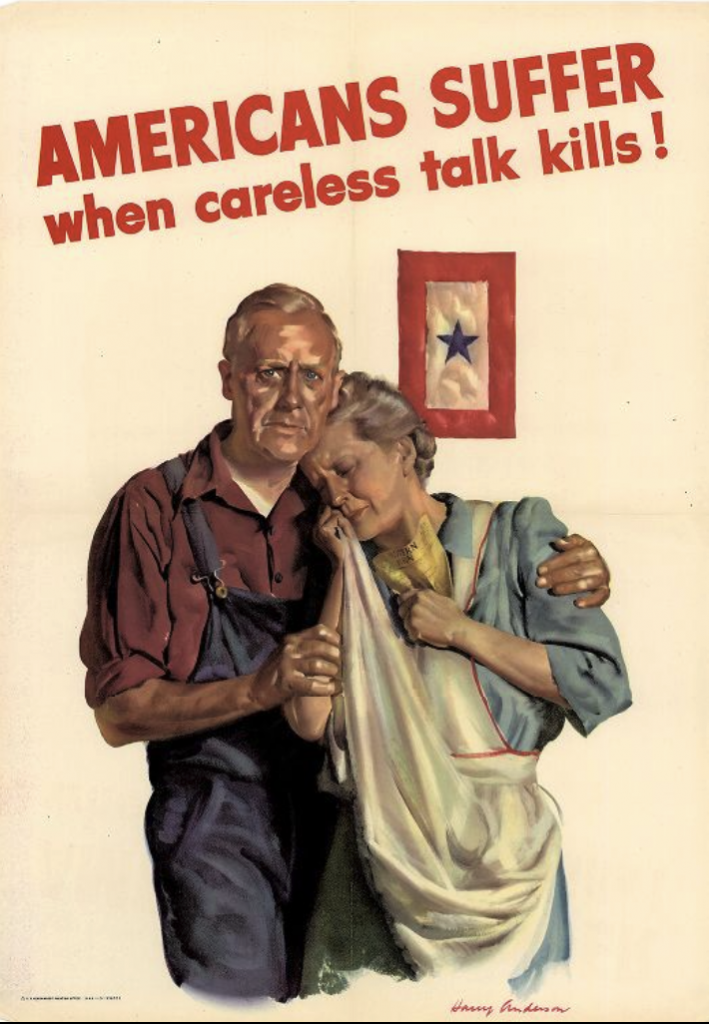
In this poster, artist Joseph Harry Anderson depicts grieving parents who have just learned of their son’s death as a result of careless talk. He intended to remind Americans that enemy agents were listening to conversations both at home and abroad. Anderson was best known for his Christian art commissioned by the Church of Jesus Christ of Latter-Day Saints and the Seventh-day Adventist Church.

Families who lost a soldier during the war received the Gold Star Flag. In this poster, artist Wesley Heyman depicts a cocker spaniel resting on a scarf that once belonged to his master in front of a Gold Star Flag. His master’s death occurred because somebody inadvertently shared sensitive information. This poster struck a chord with many. It was reproduced millions of times, shattering the record for poster requests.

Stevan Dohanos created several “Don’t Talk” posters for the OWI. He is best known for his Saturday Evening Post covers and created this sinking ship poster and this puzzle piece poster to warn against unguarded speech. He worked for the Section of Painting and Sculpture of the U.S. Treasury Department and painted murals in several post offices.
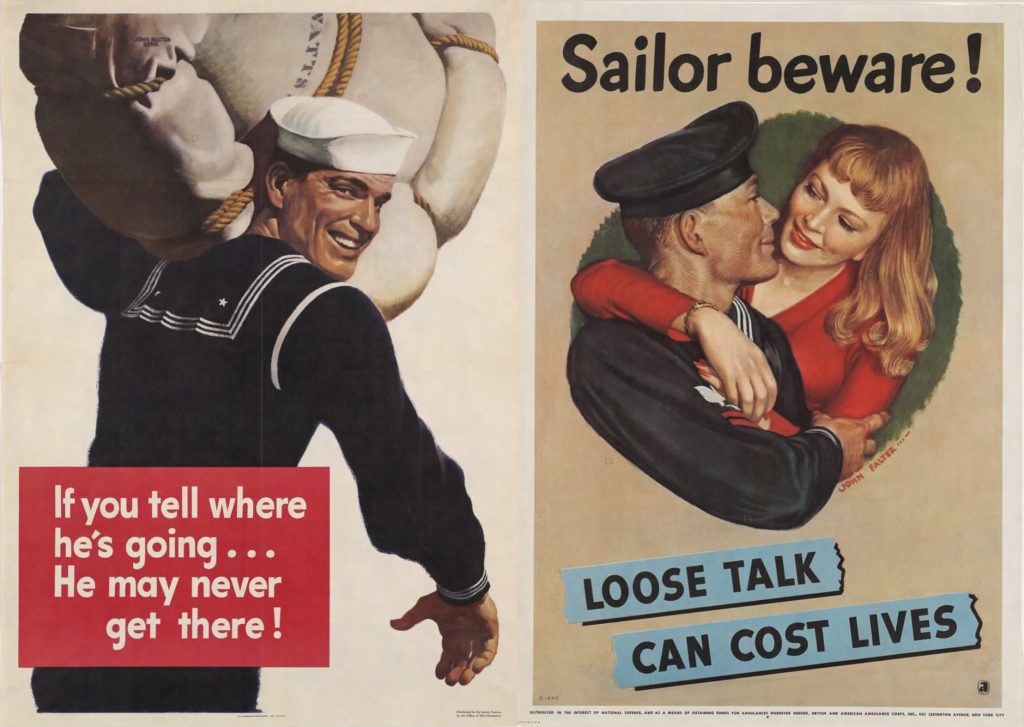
John Philip Falter created many cover paintings for the Saturday Evening Post. He enlisted in the Navy in 1943 and used his artistic skills to design more than 300 recruitment posters, including a series for the women’s Navy (WAVES). He created this Navy poster and the Sailor Beware poster to warn Americans that loose lips could result in lost lives.
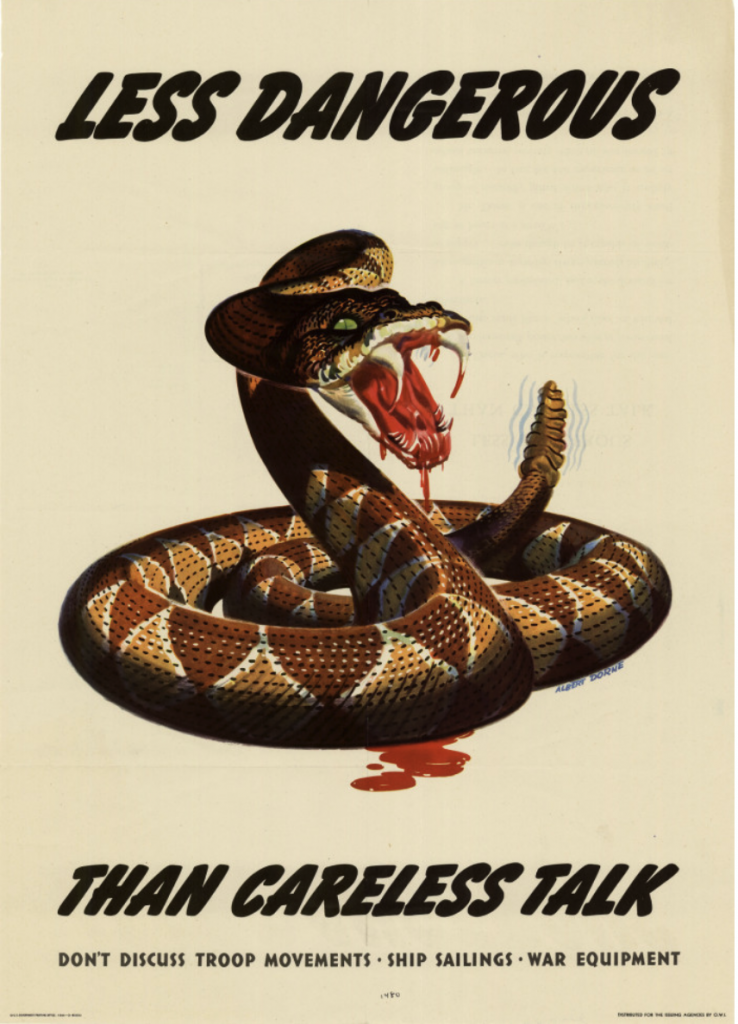
Albert Dorne was a highly successful commercial artist. Along with Norman Rockwell and several other illustrators, he founded the Famous Artists School. He created this image of a fierce rattlesnake with blood dripping from its fangs to convey the dangers of inadvertently divulging military secrets during the war.
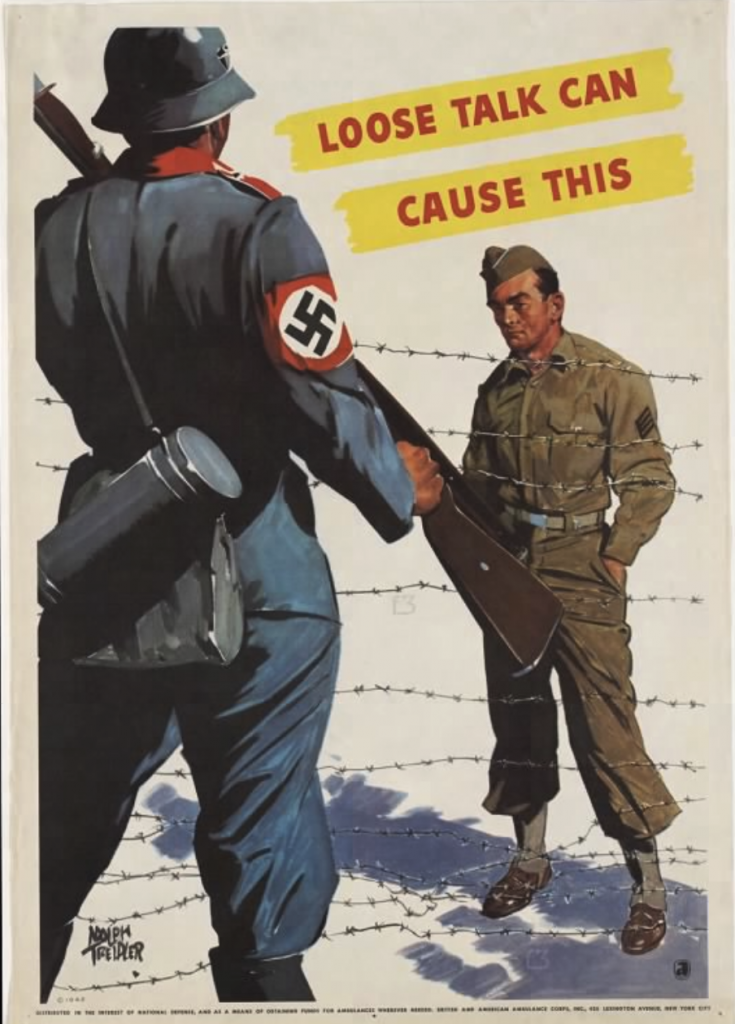
Can careless speech imprison American soldiers? Artist Adolph Treidler wanted to convey that message in this poster of an American POW. This image is one of several propaganda posters Treidler created for both WWI and WWII. Among his work was a series of posters depicting women in the workplace and Women Ordnance Workers. He is also widely known for his images promoting tourism in Bermuda.
To see more WWII propaganda posters, visit our Boston Public Library collection and see additional war posters on Fold3 today!
Any info on the pre-WWI poster featuring five dogs and a caption below picture …..
……. I’m Neutra lBUT not Afraid
of any of Them.
Thanks, Bud
Is this it?
https://www.worthpoint.com/worthopedia/wwi-wallace-robinson-1915-poster-417215212
The one where they are playing poker?
That is an amazing poster!!
I do have 3 of the IIWW propaganda posters , original, found in the shed of the house we bought a while ago. Some day I will repair them and frame as those are very precious to me.
Elizabeth if you decide to repair them, let me recommend a conservator named John Banuelos. He is in Texas but people ship to him all the time. He is an artist and an art conservator. You can go thru his website: http://www.painterofwesternlegends.com
I remember an ad on buses
“Don’t talk Chum, chew Topps Gun”
Do you know of a poster with Little Red Riding Hood and the Wolf? I saw it once. Would love to have a copy.
Hi Michelle!
I purchased a reproduction poster online several years ago that fits your description. It is a Chocolate Fondant – Kholer advertisement poster. Sorry, I cannot remember what site I found it on but if you did a search you may be able to find it.
Good Luck!
Maureen
Propaganda is disinformation!
This true Information !
Stop the bullshit!
Right!!
You should put your input into practice.
You are full of bullshit!
Propaganda can be good or bad. From Wikipedia:
“Black propaganda is a form of propaganda intended to create the impression that it was created by those it is supposed to discredit. Black propaganda contrasts with grey propaganda, which does not identify its source, and white propaganda, which does not disguise its origins at all. It is typically used to vilify or embarrass the enemy through misrepresentation.
“The major characteristic of black propaganda is that the audience are not aware that someone is influencing them, and do not feel that they are being pushed in a certain direction. Black propaganda purports to emanate from a source other than the true source. This type of propaganda is associated with covert psychological operations.[3] Sometimes the source is concealed or credited to a false authority and spreads lies, fabrications, and deceptions. Black propaganda is the “big lie”, including all types of creative deceit.[4] Black propaganda relies on the willingness of the receiver to accept the credibility of the source. If the creators or senders of the black propaganda message do not adequately understand their intended audience, the message may be misunderstood, seem suspicious, or fail altogether.
“Governments conduct black propaganda for reasons that include: A) by disguising their direct involvement a government may be more likely to succeed in convincing an otherwise unbelieving target audience, and B) there are diplomatic reasons behind the use of black propaganda. Black propaganda is necessary to obfuscate a government’s involvement in activities that may be detrimental to its foreign policies.”
I do not consider these posters to be propaganda in any true sense of the phrase. They are meant to be informative warnings and to influence the public to do something that is meant to have a positive result, such as, in this case, not carelessly giving away information that, by itself, may not seem to be of much value to the enemy, but when combined with information from multiple sources, can be helpful to the enemy.
Also, there were hundreds of different subjects on thousands of posters during the war, just in the US. They encouraged the public to save scrap for the war effort, work harder to produce more for the armed forces, etc. And, of course, recruiting posters. Wartime posters are a huge field of study, certainly not limited to careless talk.
These types of posters are more public relations than true propaganda. Of course, to some people, especially these days, anything a government tells it citizens may be propaganda!
Also from Wikipedia:
“White propaganda is propaganda that does not hide its origin or nature. It is the most common type of propaganda and is distinguished from black propaganda which disguises its origin to discredit an opposing cause.
“It typically uses standard public relations techniques and one-sided presentation of an argument. In some languages the word “propaganda” does not have a negative connotation. For example, the Russian word, propaganda (пропаганда) has a neutral connotation, similar to the English word “promotion” (of an opinion or argument). Jacques Ellul, in one of the major books on the subject of propaganda, Propaganda: The Formation of Men’s Attitudes, mentions white propaganda as an acknowledgment of the awareness of the public of attempts being made to influence it. In some states there is a Ministry of Propaganda, for instance; in such a case, one admits that propaganda is being made, its source is known, and its aims and intentions are identified. Throughout the course of a propaganda campaign, however, white propaganda may serve as a cover for black propaganda when the propagandist seeks to mask the latter. ”
I didn’t include the links to these Wikipedia entries as they are easy enough to find using a web search engine. And there are many books on the subject, including books that reproduce many of the wartime posters, as well as web sites that post images and some sell original posters (which can be quite expensive).
Propaganda????????????
Thank you, my sediments exactly. First thing I thought and it immediately provoked anger.
Yes, propaganda is define as untrue – however I would say that all of these posters are true! So I guess you couldn’t really call them propaganda! The Nazis of course would call this propaganda! There are some which distort the features of our then enemies which could properly be called propaganda!
I gave a 1940’s theme surprise 40th birthday party last year and copied about 20 posters that I found online for my walls. Therewere some amazing posters they had during WW II. Everything from “Eat your Peas and Carrots:” to “Chocolate is a Super Food” to “What if this was your child” ( a little blond German child) to “Carpool” (without about 10 people stacked in a car) . Take a few minutes to check them out. It was an amazing time.
Axis poweris printed their own such posters. In my active service time in Germany in the 1960s it was possible to find wartime anti-US posters for sale in small antique shops.
I live in Germany, I’d love to find one!
These are NOT propaganda!! Propaganda is a negative thing. These were warnings against talking about anything that would be helpful to the enemy. In those days spy’s were everywhere.
Spys
Exactly…
At least you are educated and not indoctrinated! Thank you.
Actually it IS by definition, propaganda…..”dissemination of information to influence public opinion”. You can call it anything you like, but that’s what it was and no, it’s intent was not negative.
Actually it should be ‘spies’.
Spies
I have an interesting large poster showing GI’s with Chicom soliders that says these are our allies. Never have seen another. It’s in color.
Another paper poster shows what was in a full German Div.
I took a course in modern Chinese history from Knight Biggerstaff, who happened also to have been my father’s academic advisor. Biggerstaff took time off from Cornell to serve as part of a diplomatic and military delegation to China. On the whole, he said, Mao did more with less to fight the Japanese, while Chiang Kai Shek and his crew played internal power games and looted a lot of the foreign aid. He was not a fan of Mao and his policies, but he said the Communists were united behind a common goal while the Nationalists just could not get their act together. This is why, after WW II was over, the communists made such short work of defeating the Nationalist and forcing off the mainland. Corruption and infighting did come to the Communists eventually, but in the face of a common enemy, they worked together.
They were our allies at that time.
Still true today!
“snitches Get Stitches”
These posters are done by great artists. Beautiful work.
I would love to track down the poster that Cletus “Boots” Poffenberger posed for. He was a Marine but I believe the poster was for Army recruitment. He also played professional baseball and was paid to endorse a cereal but lost the contract when he made the comment that he liked beer for breakfast. Does anyone know anything about this one?
I know that Boots Poffenberger played a lonnnnnnng time ago for my Detroit Tigers—my grandfather used to talk about a lot of Tigers players from “back in his day” .
Nobody was taking a knee back then.
Sorry to disappoint you my patriotic friend, but more than 50,000 Americans “took a knee” (deserted) in WWII. The Brits lost 100,000 to desertion. It’s time to stop glorifying WWII.
Exactly. Fighting for your country is your duty. War(s) of many variations have been fought somewhere on this earth everyday since the Fall of man.
@mark – with the millions that fought in UK and USA the meager 50k and 100k was a drop in the bucket. There has *always* been deserters, but they did not stay in their country and take a knee.
While “propaganda” can have a broader meaning, the following from the Oxford English Dictionaries conveys the generally accepted definition, “information, especially of a biased or misleading nature, used to promote or publicize a particular political cause or point of view”. Because of the negative implications of the word, I believe calling these posters “propaganda” is both misleading and disrespectful. Please reconsider your use of that term when describing these patriotic posters.
The word “propaganda” has, in modern times, rarely been used as a descriptor with a positive meaning. In what might be the most bland example, “government propaganda” has an immediately visceral negative implication today. That phrase could not be used in good conscience in any conversation or publication where the speaker or writer wished to avoid all confusion. It is, in my opinion, less than honorable to lump the transfer of facts and warnings and encouragement posted to the US and Allied Forces and home fronts during World War II into the same category as, for example, Nazi or Soviet “propaganda” or other more recent blatant disinformation campaigns designed to win at all costs, although, according to Merriam-Webster and other dictionaries, it is technically correct to do so.
I strongly object to the title of this article!
‘Propaganda’ is [usually skewed] information relayed in a fashion to make one [controlling government] look better in the eyes of another [unknowing public]… these posters were quite the opposite!
Whether we like what history was or not, and despite those who would desire to change it, we cannot; instead, please strive for accuracy.
These are CLASSIC!! I had always heard the expression, “Loose lips sink ships!,” but, never had seen the poster for it, or, the other ones!! Thanks for sharing!! My Dad was a decorated WW II Army veteran, Charlie W. Mills, Combat Engineers, First In, Last to Leave!
Regarding the poster with the gold star flag in the background and the cocker spaniel in the foreground, that is not a scarf. It is the flap of a U. S. Navy dress blue jumper. You can tell by the fold lines.
My mother was born in 1917. Around 1985 she wrote and then taped info about her life during ww11. She talked about rationing, about keeping curtains drawn, job opportunities for women, men lost in the war, rush to marry around 1942, and about Loose lips sink ships. They had a neighbor that was very very very unhappy when the US won the war. It is fascinating to see this article validate her story. Or her story validate this article.
https://i.ebayimg.com/images/g/-CQAAOSwij5boMdO/s-l400.jpg
Here’s one. I NEED BONES FOR EXPLOSIVES My parents we’re also young during WW II and they lived on the east coast with the black out curtains, and rationing, saving bones and fats to turn in for use in explosives. My uncle, 19 years old country boy, was sent to England as a tail gunner in a Flying Fortress bomber in the bombing raids over Berlin and was MIA. They headed for Poland and made their way back through Russia, Iran, Egypt and finally back to England. My father’s brother was severely wounded at the Battle of the Bulge and died at 42 after chronic disease caused by his war injuries. I have no way of knowing about the statistics above about deserters! I really doubt it! My mom said it was the worst and best of times – when the entire country pulled together to accomplish a tremendous task. She followed my dad to several bases and worked for a time in a bomb factory. The girls would write notes of the bombs – Give this one to Hitler from me!
That is most certainly not a scarf. That is part of the US Navy dress blue jumper. It’s the flap on the back.
THIS IS NOT PROPAGANDA!!
These posters were meant to remind US citizens that their indiscretions could have serious repercussions. It is NOT propaganda. Propaganda is the intentional use of falsehoods and half-truths to sway public opinion and gain control of citizenry. This title is the work of someone who either doesn’t understand propaganda or does and is trying to equate all wartime artwork with propaganda. What next, bomber nose art?
Propaganda Leaflets
In 1963 I was stationed at Camp Kaiser, Korea which was about 12 miles North of the 38th parallel and South of the DMZ.
Early one calm spring morning just as it was getting light out I was walking guard duty along one of our fence lines when all of these leaflets came floating down like it was snowing.
I picked up a few (they were in Korean) as I walked the fence line and put them in my field jacked pocket.
After I got off of guard duty and we had breakfast we formed lines and picked up all of the leaflets and were warned not to keep any and they were burned in a barrel. This was happening all over Camp Kaiser, then we went outside the fence and picked them up and burned those.
They were North Korean propaganda leaflets and some were in English threatening to destroy us and the United States, The really strange thing is it was real quiet when these these leaflets came down and I didn’t see anything in the sky but thousands of leaflets. We were told that they were dropped from balloons but none of us on guard saw anything, including balloons.
I found it funny that we burned the ones around Kaiser but they were all over the mountains around us.
The definition or opinion of propaganda has change since WW2 era. Society values change throughout time, different generations appreciate differently their surroundings that are necessary. WW2 U.S. propaganda had a purpose to educate. Would the men and women returning from the war or this country tolerate neonazi marches or displays?
No! They would also think that people who would not wear masks to protect their neighbors were selfish beasts – and would be in favor of fines or arrest to protect society. They did not allow their neighbors to decide it was “freedom” to let light out so the submarines could bomb our shores during WW II and knew exactly what to do about it! They knew that freedom stops at the tip of your own nose!
The National Archives categorizes these posters as propaganda. Propaganda was used to persuade. In this sense, the power of persuasion was intended for patriotic purposes.
There are so many negative comments! Why can’t people just discuss the history of something without individuals inserting their toxic input. Stop the bullshit of negative comments!! And yes, propaganda can be good or bad in nature. Let your intellectual curiosity guide you!
Always with the negative waves Moriarty, always with the negative waves! Lol.
Propaganda implies a biased or misleading nature, used to promote or publicize a particular political cause or point of view. Look it up. These posters were informational, not propaganda. The use of that term in this context is offensive to anyone who served. If the National Archives calls it propaganda, they are wrong too. I find the use here to be offensive and apparently so do many others.
The posters were geared toward the general public. What percentage of the public would have valuable info?
Interesting discussion about the word “propaganda.”
I enjoyed seeing the posters, but was totally offended by the email authors obvious agenda to disparage and degrade America’s security protection efforts in WWI and WWII, labeled “Propaganda”. Apparently, the goal was to imply that enemy spying has never been a problem in the past nor today. If so, this is whole piece itself Propaganda. As such, one should reflect on the poster messages; not the suggested political agenda labeling them “Propaganda”. God Bless America, and the Military Veterans who protect our Nation.
Amen. Well said.
Truth today is too often marked as fake news. This is sad
In the 1970’s, my husband’s family hosted a Japanese exchange student for a year. One day they took him to see “How Green Was My Valley,” the 1941 movie about Welch coal miners and their struggles to unionize. It is a sad movie with a message. As they were walking out of the theatre, my husband explained to the student, “We call that a “tearjerker” because it jerks the tears from your eyes.” The student nodded in appreciation for the information and said, “Ahhhh. In Japan, we call that, propaganda!” It’s all a matter of perspective folks.
My dictionary’s first definition of “propaganda” is “information, ideas, or rumors deliberately spread widely to help or harm a person, group, movement, institution, nation, etc.” This covers every way the different contributors to this comment thread have used the term (note especially “to help or harm”). Everyone’s familiar with its use to refer to negative false information about the U.S. that an adversary of ours spreads, or to refer to positive false information about that adversary–but this is only one of the ways it’s used. This article uses the term the way art historians use it, where the emphasis is on “spread widely”; the word is historically related to our word “propagate,” which is closer to its original meaning in Latin (“to be spread”).
I greatly appreciated this article, which helped me understand a WWII anecdote my mother related to me. My father, a physicist, worked on the Manhattan Project, where he remained a civilian. He was based in Chicago but frequently traveled to Oak Ridge, TN, and Los Alamos, NM, where related work was being done. My mother described how all she knew about his work was that it was top secret. The anecdote I have in mind was about how his superiors were most concerned when his mother mentioned to friends that he was on a trip to Tennessee; after that all she or my own mother were told about his trips was how to reach him in an emergency. It had never occurred to me to relate locations he was traveling to to information about the locations of troop deployments! Clearly his superiors had paid attention to this much more general campaign that the article is about; the artists discussed had done an excellent job of spreading it to all of American society.
Amazing works of art! However, the word “propaganda” evokes thoughts of Tokyo Rose disseminating false and misleading information to undermine the efforts of the Allied troops. The posters were made to inform and protect – quite the opposite intent of typical propaganda of the day.